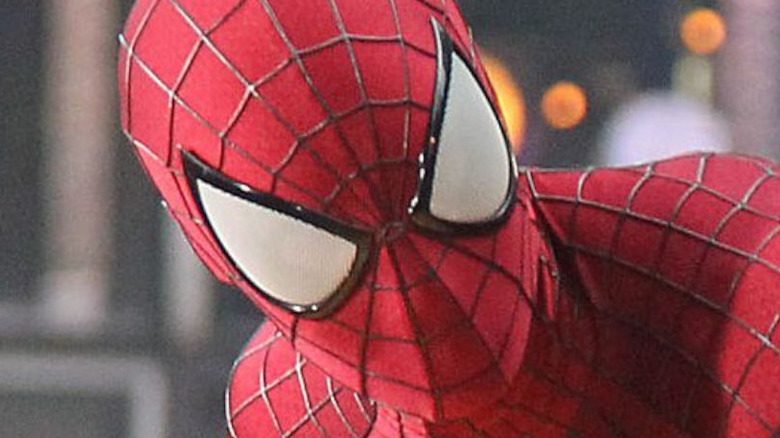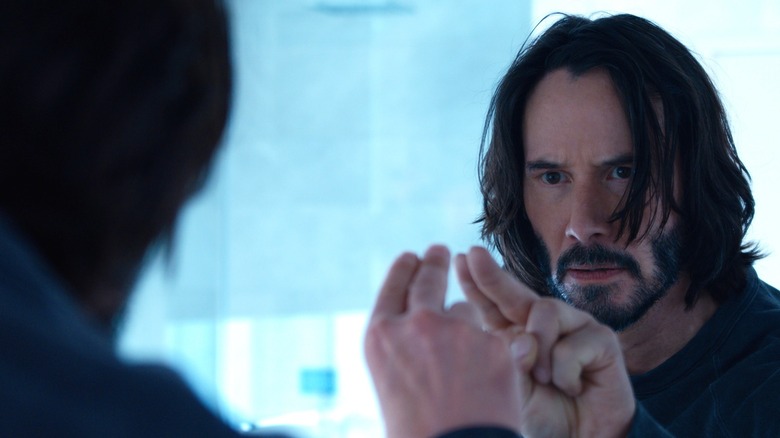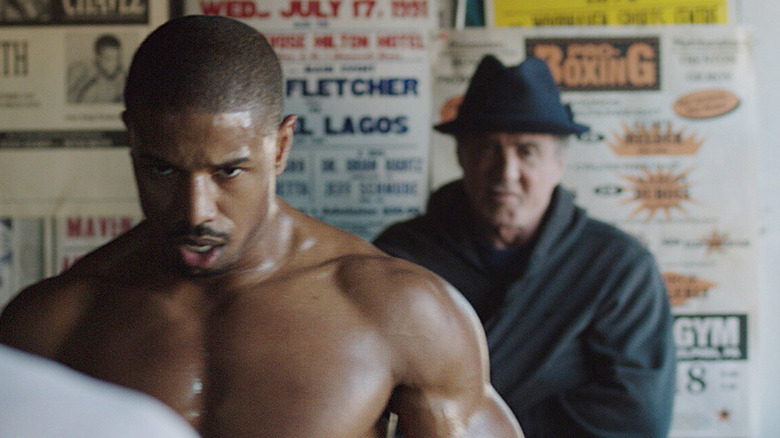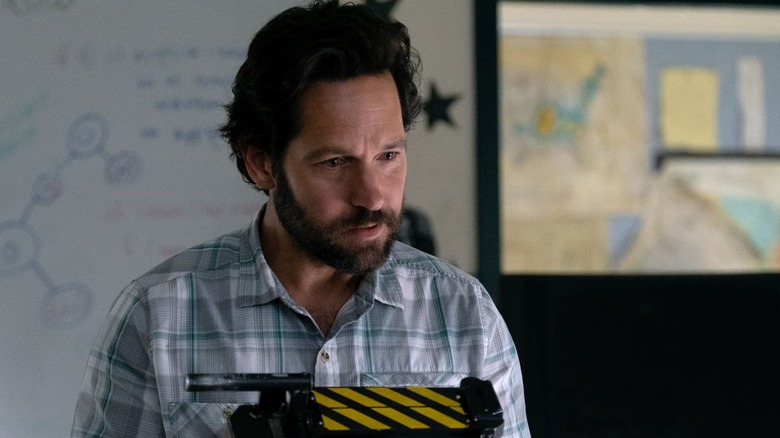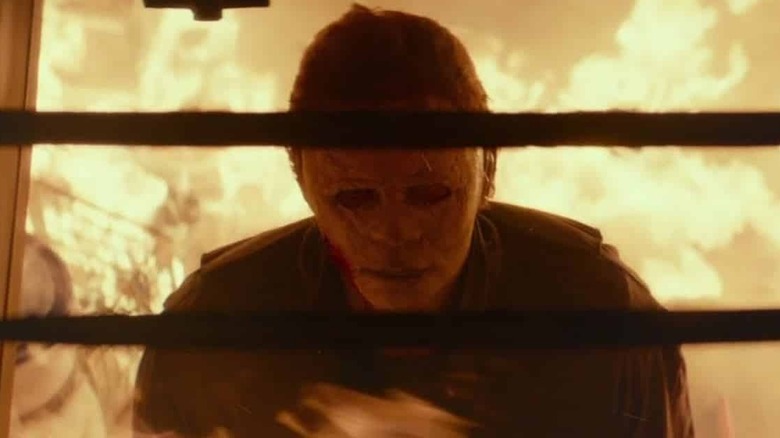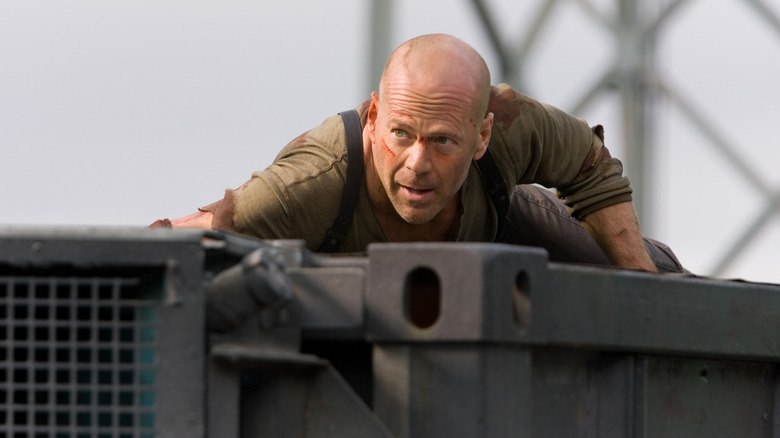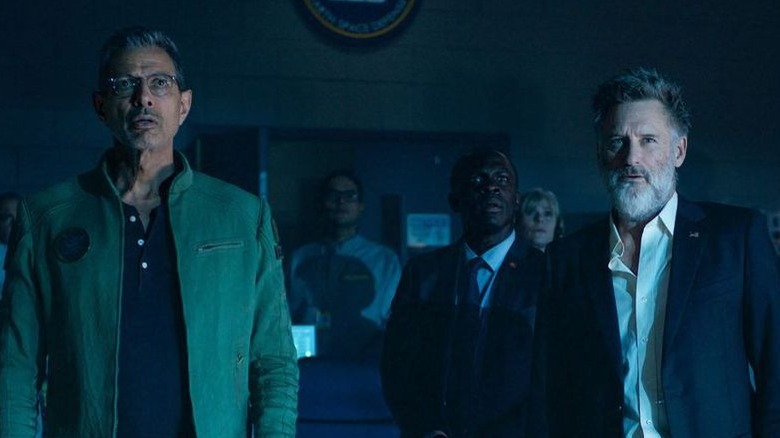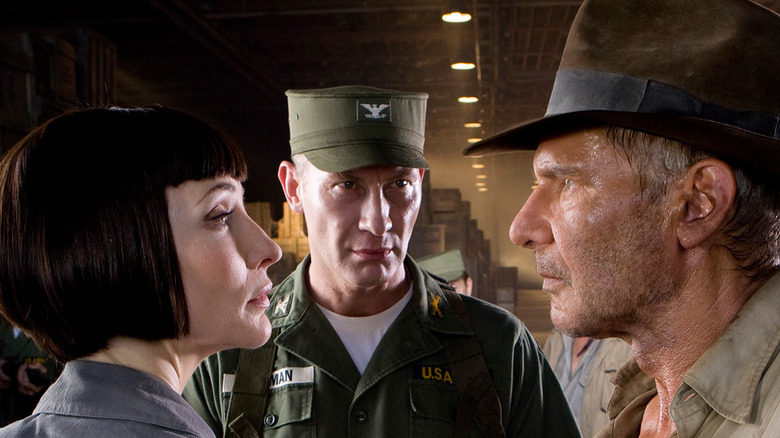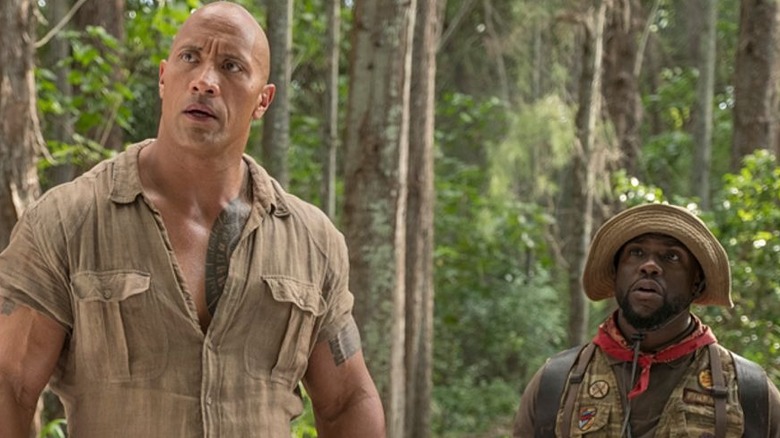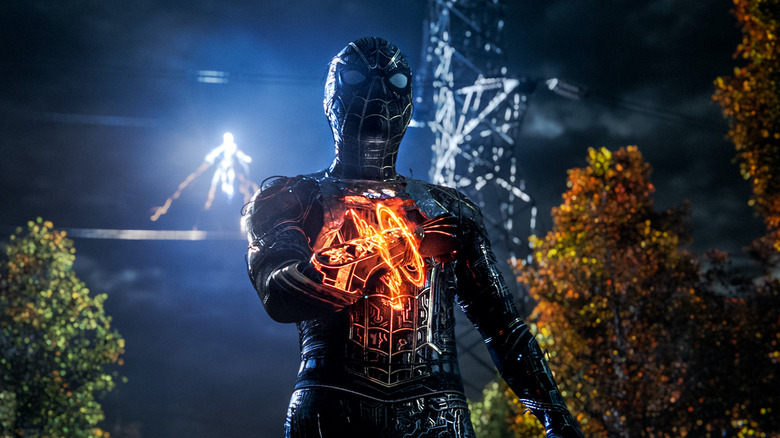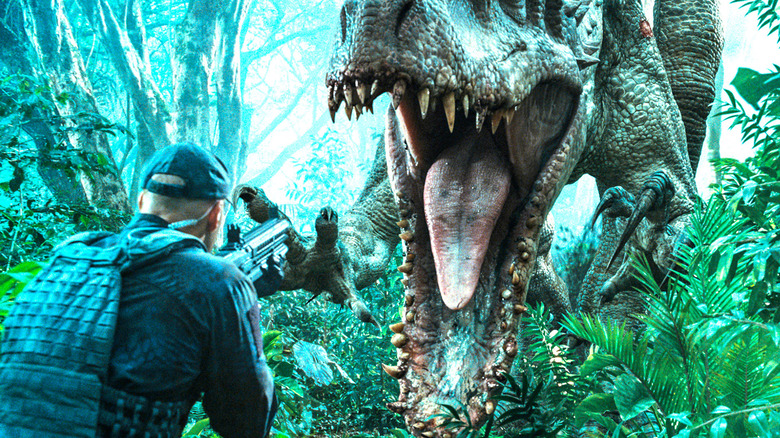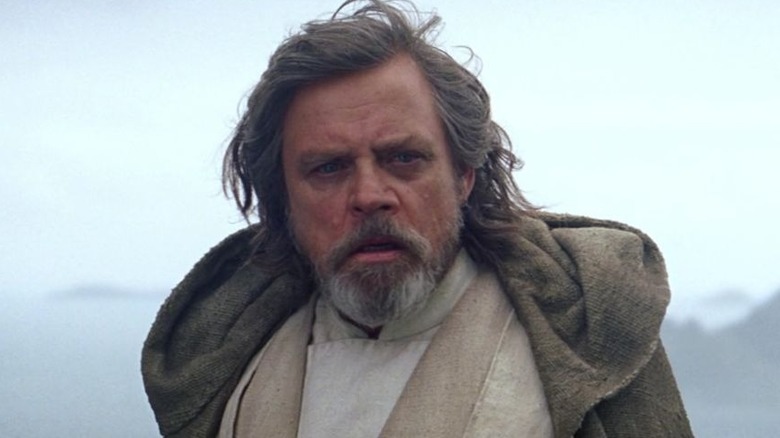Legacy Sequels Ranked At The Box Office
Nostalgia is one of the most reliable forces in the moviegoing universe. There's nothing movie studios love more than reliability (well, except for money. They love that.) Hence, the rise of the legacy sequel. Legacy sequels are distinct from regular sequels. Your everyday, ho-hum sequel usually comes out fairly soon after the last movie (ideally two to four years) and continues the story, even if only vaguely. On the other hand, a legacy sequel comes out at least 10 years after the last movie, features original cast members often "passing the torch" to a new cast, and most importantly, relies heavily on its nostalgia factor — or what cinematic cynics call "shameless fan service."
Thus, "Mad Max: Fury Road" is not a legacy sequel despite coming out 30 years after "Mad Max: Beyond Thunderdome," while "Jurassic World" is a legacy sequel, even though it "only" came out 14 years after "Jurassic World III." Why? "Fury Road" was just another "Mad Max" movie (albeit a great one), while "Jurassic World" was promoted and produced with audience nostalgia being a main selling point. Put another way, a legacy sequel is built around the franchise's legacy. But just because audiences chomp down nostalgia like movie theater popcorn with extra butter doesn't mean every legacy sequel has been a blockbuster. Far from it. Which sequels honored their heritage and which ones fell flat? Here are legacy sequels ranked at the box office!
12. The Matrix Resurrections
"The Matrix" franchise has earned $1.7 billion worldwide across four films, for a per-film average of $434 million. Pretty impressive, especially considering the groundbreaking, mind-bending franchise has always been rated R — despite appealing to teenage males who can't (legally) buy tickets to see them — and most of the movies were released nearly 20 years ago. However, what isn't so impressive is the worldwide box office gross of the latest entry, "The Matrix Resurrections," which currently stands at $106 million, less than any of the previous three films' domestic gross and almost what "The Matrix Reloaded" earned in only three days in 2003. Yikes!
With an estimated budget of at least $150 million, "The Matrix Resurrections" could lose more than $150 million at the box office, based on the rule-of-thumb that a movie has to earn twice its budget to cover marketing costs. So why is "The Matrix Resurrections" such a box office bomb? Don't blame COVID-19, as "Spider-Man: No Way Home" was 2021's biggest hit. And don't blame Warner Brothers simultaneously releasing movies on HBO Max, as "Godzilla vs. Kong" was WB's biggest box office earner of the year, and the eighth biggest in 2021. Blame the lackluster box office of "Resurrections" on the series' diminishing returns, especially "The Matrix Revolutions," which ended the trilogy on a sour note and $427 million worldwide, a massive 43% drop from "The Matrix Reloaded" just six months earlier. Simply put, moviegoers weren't too excited to reenter "The Matrix," while the marketing relied exclusively on nostalgia that wasn't there.
11. Creed
Rocky is so rich with nostalgia that it has gotten not one, but two legacy sequels. But what else would you expect from a franchise that is so iconic it has a freaking statue? Starting with "Rocky" in 1976, the Italian Stallion series had been going at a steady clip of one sequel every two to five years. That changed when Stallone hung up the gloves with 1990's "Rocky V," an underwhelming conclusion that ended the series on a sour note for both critics and fans. It also earned a mere $119 million worldwide, a steep drop from the franchise high of $300 million worldwide for "Rocky IV."
Rocky was not supposed to end this way, so Stallone gave his most famous character one last go (or so he thought) with 2006's "Rocky Balboa." With strong marks from both audiences and critics, and a solid $156 million in the bank, "Rocky Balboa" earned money on its $24 million budget and ended the series on a strong note (or so we thought). Nine years later came another legacy sequel, the reboot "Creed" in 2015. With Rocky retired, the central pugilist this time was his old frenemy Apollo Creed's illegitimate son, Adonis. It was a clever pitch, one which revived the series to the tune of $173 million worldwide. That's a hefty profit on a $37 million budget, though still just a fraction of what real-life boxer Floyd "Money" Mayweather earns for one fight.
10. Ghostbusters: Afterlife
The "Ghostbusters" franchise has basically consisted of three attempts to replicate the one-shot-in-a-million success of the original 1984 classic. You may be thinking, "Sure, but doesn't that basically describe every franchise?" Yes, but not many besides "Ghostbusters" take 37 years to finally get it right. After "Ghostbusters II" underwhelmed with critics and fans (and made $80 million less than the original) the gang hung up their proton packs. While fans clamored for the original cast to get back together for the next two-and-a-half decades, that proved untenable, so Sony got antsy and rebooted the series with an all-new cast in 2016.
That move proved popular with critics but not so much with moviegoers, though truthfully "Ghostbusters: Answer The Call" was always going to have a tough time earning money on its $144 million budget. So Sony shaved the budget in half for 2021's "Ghostbusters: Afterlife" and brought the band back together. While the film's worldwide gross is notably less than the 2016 "failure" ($184 million vs. $229 million), it made more money due to its more modest budget. And that's all that matters, no matter who you're gonna call.
9. Terminator: Dark Fate
You'll be forgiven if you didn't know 2019's "Terminator: Dark Fate" is technically a legacy sequel, as the "Terminator" franchise's timelines are more convoluted and confusing than their time travel scenarios. Basically, after 2015's "Terminator: Genisys" bombed in the U.S., but was saved by China, Paramount decided to ignore the previous timeline and make a direct sequel to "Terminator 2: Judgment Day" (the last "Terminator" movie everybody actually liked) from 27 years earlier.
There were two problems. Besides bringing back Linda Hamilton's Sarah Connor, the connection of "Dark Fate" to the first two films wasn't clear. Secondly, and most significantly, nobody really cared. There had been three "Terminator" movies in between "Judgment Day" and "Dark Fate," with none of them particularly well-liked, so going the legacy sequel route reeked of desperation and was met with a collective "So what?" Despite boasting some of the best reviews of the series, "Dark Fate" bombed in the U.S. and this time China wasn't there to save it. Had "Dark Fate" been a true legacy sequel, and there weren't three mediocre "Terminator" movies plus one TV series, we imagine the film would have done much better.
8. Halloween
"Halloween" isn't so much one franchise but more like five. The 12 (and counting) films basically make up three series, one spin-off and one remake. Trying to make sense of it is almost as hard as trying to kill Michael Myers. However, the franchise also has not one, but two legacy sequels. While legacy sequels are all the rage now, they weren't really in the 1990s. In 1998, "Halloween H20" brought back Jamie Lee Curtis' Laurie Strode, who died off-screen between "Halloween II" and "Halloween 4," and erased the previous four films.
With us so far? You may be confused, but moviegoers were into it, as "H20" managed $55 million worldwide, almost as much as the previous four Curtis-less movies made combined. However, the franchise once again lost its way over the next 20 years, so Universal once again "broke glass in case of emergency" and brought back Curtis' Strode for "Halloween" in 2018, this time ignoring every other movie and serving as a direct sequel to the 1978 original. It worked out pretty well: On a $10 million budget, "Halloween" earned $255 million worldwide.
7. Live Free or Die Hard
While some may think the legacy sequel craze got started in 2015 when "Jurassic World" and "Star Wars: The Force Awakens" topped the box office charts, it had actually been going strong since at least the mid-2000s with "Rocky Balboa" in 2006, "Live Free or Die Hard" in 2007, and "Rambo" and "Indiana Jones and the Kingdom of the Crystal Skull" in 2008. Since we didn't have the term "legacy sequel" just yet, it was more of an old-timer action hero trend. You better believe Arnold Schwarzenegger wanted in, but he was too busy being Governator of California.
Out of this group of geezers, John McClane stood second only to Dr. Jones. "Live Free or Die Hard" was the first "Die Hard" film in 12 years since "Die Hard: With A Vengeance" in 1995, and despite Bruce Willis' McClane spewing fatherly advice to Justin Long (what a strange torch passing, but whatever) it was really just another John McClane adventure. Which was good enough for moviegoers, who missed the good cop with bad luck, to the tune of $382 million worldwide — a pretty decent payout on its $110 million budget.
6. Independence Day: Resurgence
When it comes to big movies, profitability matters. So while 2016's "Independence Day: Resurgence" is technically one of the highest-grossing on this list, it's also one of the biggest misfires. Of course, you can't really blame 20th Century Fox for writing a $165 million check. The year before, both "Jurassic World" and "Star Wars: The Force Awakens" banked more than $1.5 billion, and the original "Independence Day" earned $817 million worldwide in 1996, making it not only the biggest hit of 1996, but one of the highest-grossing films of the 1990s.
Alas, the final tally for "Independence Day: Resurgence" — $384 million — was less than half what the original earned in 1996 and barely broke even on its budget. What happened? Well, for starters it was really, really not good. Secondly, it didn't feature the original film's star, always a risky proposition, and probably fatal when the aforementioned star is Will Smith. Finally, the original film ended well. The aliens were defeated, humanity was saved, it was all good in the 'hood. Thus, despite the tagline being "We always knew they'd come back," the sequel felt less like an organic continuation of the story and more like a shameless cash grab. Not surprisingly, it didn't grab much cash.
5. Indiana Jones and the Kingdom of the Crystal Skull
Despite being based on 1940s adventure serials — which B-level studios churned out with the efficiency of an assembly line — and being George Lucas and Steven Spielberg's answer to the James Bond franchise (25 official films and counting), Indiana Jones hasn't been a very prolific character. Dr. Jones has had only four big screen adventures in 27 years, with a fifth slated for 2023, 15 years since the last one and almost as big a gap as between "The Last Crusade" and "Kingdom of the Crystal Skull."
Don't blame star Harrison Ford's busy schedule, as we imagine he'd happily don the bullwhip and fedora to show up at an opening for a new car dealership in Pasadena. Ford finally got his long sought-after wish and played Indiana Jones again for 2008's "Crystal Skull." Despite having a vague marketing campaign that basically just said, "Hey, it's another Indiana Jones movie," the film opened to $100 million domestically, and earned $786 million worldwide, the best in the series, sans inflation, and the second highest-grossing film of 2008, behind only Christopher Nolan's record-breaking "The Dark Knight."
4. Jumanji: Welcome to the Jungle
Is "Jumanji: Welcome to the Jungle" a legacy sequel, reboot, or reimagining? The answer is "Yes." Besides the title and basic premise, the 2017 sequel bears almost no resemblance to the 1995 original — and it was better off for it. The original "Jumanji" succeeded as a one-and-done, Robin Williams star vehicle, while "Welcome To The Jungle" is the sort of action-comedy hybrid that has made Dwayne Johnson's bank account bigger than his biceps. It's the kind of rebrand that rarely works well and almost never works better. Yet "Welcome To The Jungle" did a lot better.
"Jumanji" earned a respectable $262 million worldwide in 1995 on a $65 million budget. "Welcome to the Jungle" earned an incredible $961 million worldwide, and only cost $25 million more, thanks to its economical $90 million budget. "Welcome To The Jungle" turned the "Jumanji" brand into Hollywood's most unlikely mega-franchise, and it did so by being thematically different from the original. So it begs the question — does "Welcome To The Jungle" even qualify as a legacy sequel? We think so. While there is no official passing of the torch, there's still a whole new cast. Also, "Welcome To The Jungle" does rely on some audience nostalgia for the original, though it never descends into shameless fan service.
3. Spider-Man: No Way Home
Spoilers ahead for "Spider-Man: No Way Home."
"Spider-Man: No Way Home" is basically the "Avengers Endgame" of the Spider-Man franchise. And we do mean the entire Spider-Man franchise ... well, live action at least (sorry, "Into the Spider-Verse" fans). On the one hand, it's a trilogy capper to Tom Holland's MCU "Spider-Man" series. On the other hand, it's a legacy sequel to not just one, but two other franchises — the Tobey Maguire-Sam Raimi "Spider-Man" series and the Andrew Garfield-Marc Webb "Amazing Spider-Man" duo. While Maguire and Garfield were not specifically advertised in the film's marketing, their respective rogues galleries were. And come on, you just knew they were both going to show up.
Even without their mugs on the poster, nostalgia was a major selling point for this picture. And Spider-Man has a lot of nostalgia to draw from. Every Spider-Man movie has made a lot of money, even the underwhelming "Amazing Spider-Man" films. Despite this legacy, even Sony probably found it, well, amazing just how much money "Spider-Man: No Way Home" has made. It opened to $260 million, almost two-and-a-half times as much as "Spider-Man: Far From Home" and the second biggest opening weekend of all time, behind only "Avengers Endgame." How high can Spidey climb? Well, given that it's already the highest-grossing solo superhero movie of all time, we'd say pretty high — especially when it stars three Spider-Men.
2. Jurassic World
In a box office culture saturated with superhero movies, it's easy to overlook just how dominant the dinosaurs from "Jurassic Park" have been. The series is one of only three (alongside "The Avengers" and "Batman") to have broken the opening weekend record at least three times. Out of five movies, it boasts three billion-dollar grossers, which is even more impressive, as "Jurassic Park" was released in 1993 and was the highest-grossing movie of all time until it was toppled by "Titanic" in 1997.
So in hindsight, it was a little naive to think "Avengers: Age of Ultron" would easily run roughshod over summer 2015, while "Jurassic World" would be left picking up the scraps. Sure, "Age of Ultron" was the follow-up to the record-breaking "The Avengers," but "Jurassic World" was the legacy sequel to one of the most beloved franchises ever. In this round, the dinosaurs won the day. "Jurassic World" broke the opening weekend box office record set in 2012 by "The Avengers" and earned $1.67 billion worldwide, almost $700 million more than "The Lost World: Jurassic Park" and "Jurassic Park III" combined. Turns out 65 million years worth of nostalgia is a very powerful force indeed.
1. Star Wars: The Force Awakens
"Star Wars: The Force Awakens" — and indeed, the entire Disney "Star Wars" franchise from film to TV — has basically become the poster child for fan service and nostalgia. But with more than $5 billion across five films (not to mention the number of people who subscribed to Disney+ for "The Mandalorian"), we'd say Disney is doing all right with their decision. Sure, we can argue that "The Force Awakens" may have borrowed too heavily from "A New Hope," to the point that it was a borderline remake. But when you get down to it, you just couldn't beat the cinematic experience of seeing that movie for the first time in 2015.
J.J. Abrams and company certainly had their work cut out for them. After George Lucas' popular, but divisive, prequel trilogy left fans feeling ignored, the filmmaking crew for "The Force Awakens" went in the opposite direction, filling their movie with so much fan service and nostalgia that longtime "Star Wars" fans couldn't help but feel the love. Cynics may have complained, but everyone else seemed to enjoy themselves. And we do mean everyone (even President Obama mentioned it): "Star Wars: The Force Awakens" opened to a then-record $247 million, outgrossing the previous best December weekend, "The Hobbit," by $163 million, on its way to $2 billion worldwide — including $936 million domestically, still the biggest domestic gross of all time.
